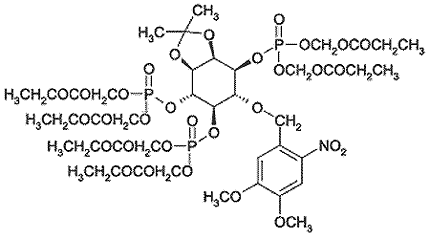Ins (1,4,5)P3 derivative with a cage on position 6. Light pulse to destroy cage ~360nm.
Product Details
| Alternative Name: | D-2,3-O-Isopropylidene-6-O-(2-nitro-4,5-dimethoxy)benzyl-myo-inositol 1,4,5-trisphosphate-hexakis(propionoxymethyl)ester |
| |
| Formula: | C42H64NO31P3 |
| |
| MW: | 1171.9 |
| |
| Purity: | ≥98% (HPLC) |
| |
| Identity: | Identity determined by 1H-NMR, 31P-NMR and MS. |
| |
| Appearance: | Oil |
| |
| Solubility: | Soluble in DMSO, dichloromethane or methanol. |
| |
| Shipping: | Blue Ice |
| |
| Long Term Storage: | -20°C |
| |
| Use/Stability: | Stock solutions in dry DMSO are stable for up to 2 weeks if stored at -20°C. Do not freeze mixtures of Pluronic®, DMSO and inositolphosphates! |
| |
| Handling: | Protect from light and moisture. Avoid freeze/thaw cycles. After reconstitution, prepare aliquots and freeze in liquid nitrogen. |
| |
| Technical Info/Product Notes: | In order to generate the biologically active compound this derivative requires the intracellular enzymatic hydrolysis of several protecting groups, e. g. acyloxymethyl esters. The highly complicated kinetics of these biochemical steps may lead to unphysiological effects. The physiological signal usually appears to be very rapid. The photolysis of membrane-permeant caged derivatives of Ins(1,4,5)P3 and other inositol polyphosphates might mimic fast intracellular responses.In an initial step cells are loaded with the caged Ins(1,4,5)P3 derivative. Within 30 to 120 minutes all bioactivatable protecting groups are enzymatically removed, generating caged Ins(1,4,5)P3. The cage is known to prevent biological activity when placed at the right position, in this case the 6-hydroxygroup. The photochemical destruction of the cage (~360nm) releases active Ins(1,4,5)P3 within a few seconds, thus mimicking the rapid responses of the receptor/phospholipase C signalling system in the cell. Since this approach does not directly trigger other signalling events, for instance PKC activation after receptor-mediated diacylglycerol (DAG) formation, membrane-permeant derivatives of signalling molecules are able to help dissecting signalling pathways.
Includes 1 vial of 10% Pluronic® (F127) solution in DMSO. |
| |
| Protocol: | Recommendations on application:
- For incubations, dissolve an aliquot of the cell penetrating compound in dry DMSO.
- Take out a small amount (e.g. 1µl) and mix with same amount of Pluronic F127 in DMSO (10%).
- To this mixture add 100µl of the serum-free cell supernatant, mix thoroughly with a pipette and immediately add back to the cells. The final DMSO concentration in the experiment should not exceed 0.5%. The final concentration of caged-iso-Ins(1,4,5)P3/PM should be in the 1-3µM range, depending on the cell type.
- For calcium measurements after un-caging use one of the standard calcium sensors.
- Incubation in the dark at room temperature for the cell penetrating compound and the calcium sensor should be 30-120 min.
- Subsequently, it is possible to return to different buffers (with serum, if necessary).
- If buffer is not changed, calcium levels can be measured within 5-10 min. If buffers are changed, a longer adaptation phase (30 min.) is recommended.
- To un-cage caged-iso-Ins(1,4,5)P3/PM, scan cells once with an excitation around ~360nm of an argon-ion UV laser or another UV light source. |
| |
| Regulatory Status: | RUO - Research Use Only |
| |
Please mouse over
Product Literature References
CO2 Levels Modulate Carbon Utilization, Energy Levels and Inositol Polyphosphate Profile in Chlorella: M.M. Pineda, et al.; Plants
12, 129 (2023),
Abstract;
Imidazobenzodiazepine PI320 Relaxes Mouse Peripheral Airways by Inhibiting Calcium Mobilization: J.F.P. Zoghbi, et al.; Am. J. Respir. Cell Mol. Biol.
67, 482 (2022),
Abstract;
Intercellular Calcium Signaling Induced by ATP Potentiates Macrophage Phagocytosis: S. Zumerle, et al.; Cell Rep.
27, 1 (2019),
Abstract;
Full Text
Defective rapid cell shape and transendothelial migration by calpain-1 null neutrophils: R. Ishak, et al.; Biochem. Biophys. Res. Commun.
506, 1065 (2018),
Abstract;
Impact of Janus Kinase 3 on Cellular Ca2+ Release, Store Operated Ca2+ Entry and Na+/Ca2+ Exchanger Activity in Dendritic Cells: J. Yan, et al.; Cell. Physiol. Biochem.
36, 2287 (2015),
Application(s): Whole-cell patch clamp,
Abstract;
Full Text
Co-incident signalling between mu-opioid and M3 muscarinic receptors at the level of Ca2+ release from intracellular stores: lack of evidence for Ins(1,4,5)P3 receptor sensitization: D.S. Samways, et al.; Biochem. J.
375, 713 (2003),
Abstract;
Full Text
Phosphorylation of type-1 inositol 1,4,5-trisphosphate receptors by cyclic nucleotide-dependent protein kinases: a mutational analysis of the functionally important sites in the S2+ and S2- splice variants: L.E. Wagner, 2nd, et al.; J. Biol. Chem.
278, 45811 (2003),
Abstract;
Full Text
Cell-permeant caged InsP3 ester shows that Ca2+ spike frequency can optimize gene expression: W. Li, et al.; Nature
392, 936 (1998),
Abstract;












